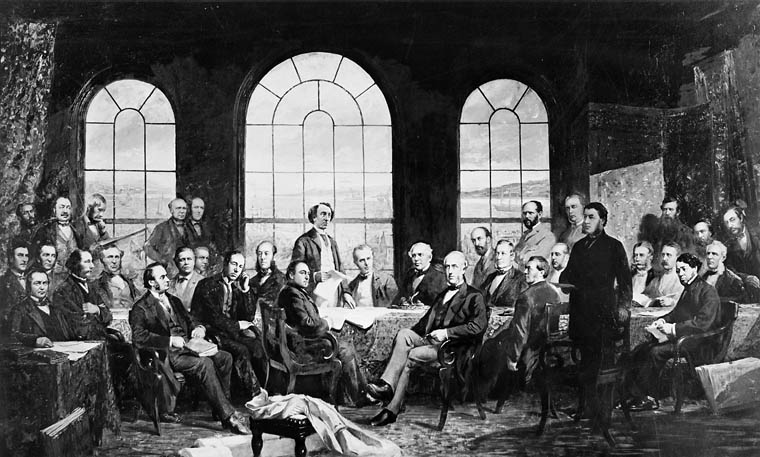Article
Devon Island Miocene Fossils
FOSSIL bones were first discovered in 1978 in the rocks formed in the now vanished Haughton Lake.

Enter your search term
Signing up enhances your TCE experience with the ability to save items to your personal reading list, and access the interactive map.
Create AccountArticle
FOSSIL bones were first discovered in 1978 in the rocks formed in the now vanished Haughton Lake.
"https://www.thecanadianencyclopedia.ca/images/tce_placeholder.jpg?v=e9dca980c9bdb3aa11e832e7ea94f5d9" // resources/views/front/categories/view.blade.phphttps://www.thecanadianencyclopedia.ca/images/tce_placeholder.jpg?v=e9dca980c9bdb3aa11e832e7ea94f5d9

Article
Gem-quality diamonds crystallize as octahedrons (8 faces), trisoctahedrons (24 faces), hexoctahedrons (48 faces) or a combination of these. Diamond owes its supreme standing among all the gemstones to 4 specific attributes.
"https://d3d0lqu00lnqvz.cloudfront.net/media/media/1c5e002b-c29d-45d2-a47a-a0628acf2581.jpg" // resources/views/front/categories/view.blade.phphttps://d3d0lqu00lnqvz.cloudfront.net/media/media/1c5e002b-c29d-45d2-a47a-a0628acf2581.jpg

Article
Dinosaurs were a group of animals that dominated the land environments of every continent. They lived from the late Triassic period to the end of the Cretaceous period (225 to 65 million years ago). However, birds are the direct descendants of dinosaurs, meaning dinosaurs are still common today. Paleontologists have found at least 88 different species of dinosaurs in Canada (see also Dinosaurs Found in Canada). The primary site of these fossils is Dinosaur Provincial Park, Alberta. Well-known dinosaurs first named from Canadian specimens include Albertosaurus, Centrosaurus, Corythosaurus, Dromaeosaurus,Gorgosaurus, Lambeosaurus, Pachyrhinosaurus, Parasaurolophu sand Styracosaurus.
"https://d3d0lqu00lnqvz.cloudfront.net/TCEImages/Albertosaurus.jpg" // resources/views/front/categories/view.blade.phphttps://d3d0lqu00lnqvz.cloudfront.net/TCEImages/Albertosaurus.jpg

Article
Members of the Central Asiatic Expedition, led by the American Museum of Natural History, first recognized dinosaur eggs in Mongolia in the 1920s. Since then, paleontologists have discovered fossilized remains of dinosaur eggs at over 200 locations worldwide. These locations include sites in Africa, China, Europe, India, Korea, and the Americas. The first dinosaur eggs from North America were discovered in Montana in the late 1970s. In Canada, dinosaur eggshell fragments were initially found in the early 1980s. Complete dinosaur eggs were discovered in 1987 at a site in southern Alberta known as Devil’s Coulee.
"https://d3d0lqu00lnqvz.cloudfront.net/media/media/9d78aa4e-0856-4fac-97f9-c78676629ca4.jpg" // resources/views/front/categories/view.blade.phphttps://d3d0lqu00lnqvz.cloudfront.net/media/media/9d78aa4e-0856-4fac-97f9-c78676629ca4.jpg

Article
Most early discoveries were made in artificial excavations, eg, rock quarries or coal mines.
"https://d3d0lqu00lnqvz.cloudfront.net/media/media/e8e23bed-66e7-4173-9e92-b61c0b06e940.jpg" // resources/views/front/categories/view.blade.phphttps://d3d0lqu00lnqvz.cloudfront.net/media/media/e8e23bed-66e7-4173-9e92-b61c0b06e940.jpg

Article
The dipper (Cinclidae) family of birds comprises 5 species of birds known colloquially as water ouzel.
"https://d3d0lqu00lnqvz.cloudfront.net/media/media/e2eb8f1d-d403-4bf9-87d8-cda7c2ff2e86.jpg" // resources/views/front/categories/view.blade.phphttps://d3d0lqu00lnqvz.cloudfront.net/media/media/e2eb8f1d-d403-4bf9-87d8-cda7c2ff2e86.jpg

Article
The dobsonfly is a large (100-140 mm), soft-bodied freshwater insect of order Megaloptera, family Corydalidae; smaller forms are called fishflies.
"https://www.thecanadianencyclopedia.ca/images/tce_placeholder.jpg?v=e9dca980c9bdb3aa11e832e7ea94f5d9" // resources/views/front/categories/view.blade.phphttps://www.thecanadianencyclopedia.ca/images/tce_placeholder.jpg?v=e9dca980c9bdb3aa11e832e7ea94f5d9

Article
Dock, herbaceous plant of genus Rumex, family Polygonaceae (buckwheat); most docks are perennial.
"https://d3d0lqu00lnqvz.cloudfront.net/media/media/455358cb-1299-4193-8369-04e4d7853231.jpg" // resources/views/front/categories/view.blade.phphttps://d3d0lqu00lnqvz.cloudfront.net/media/media/455358cb-1299-4193-8369-04e4d7853231.jpg

Article
Dog (Canis familiaris) is a carnivorous mammal, and probably the first domesticated animal. In Canada, dogs were first kept by Indigenous peoples. The Canadian Kennel Club recognizes 187 breeds, five of which are uniquely Canadian: the Tahltan bear dog, the Canadian Inuit dog, the Nova Scotia duck-tolling retriever, the Newfoundland dog and the Labrador retriever. A sixth dog breed indigenous to Canada, the Salish woolly dog, went extinct before the Canadian Kennel Club officially registered it as a breed.
"https://d3d0lqu00lnqvz.cloudfront.net/media/media/deecf112-740f-4f90-9728-1699df21682a.jpg" // resources/views/front/categories/view.blade.phphttps://d3d0lqu00lnqvz.cloudfront.net/media/media/deecf112-740f-4f90-9728-1699df21682a.jpg

Article
Dogwood (Cornaceae), family of perennial herbaceous plants, trees and shrubs, represented in North America by about 15 members of the genus Cornus.
"https://www.thecanadianencyclopedia.ca/images/tce_placeholder.jpg?v=e9dca980c9bdb3aa11e832e7ea94f5d9" // resources/views/front/categories/view.blade.phphttps://www.thecanadianencyclopedia.ca/images/tce_placeholder.jpg?v=e9dca980c9bdb3aa11e832e7ea94f5d9

Article
Dolphin and Porpoise, are the common names for small, toothed mammals of the order Cetacea which also includes whales.
"https://d3d0lqu00lnqvz.cloudfront.net/media/media/28264f26-4fe4-4487-8190-683ffef8a53c.jpg" // resources/views/front/categories/view.blade.phphttps://d3d0lqu00lnqvz.cloudfront.net/media/media/28264f26-4fe4-4487-8190-683ffef8a53c.jpg

Article
Dominion of Canada is the country’s formal title, though it is rarely used. It was first applied to Canada at Confederation in 1867. It was also used in the formal titles of other countries in the British Commonwealth. Government institutions in Canada effectively stopped using the word Dominion by the early 1960s. The last hold-over was the term Dominion Day, which was officially changed to Canada Day in 1982. Today, the word Dominion is seldom used in either private or government circles.
"https://d3d0lqu00lnqvz.cloudfront.net/media/media/143f8587-f938-4cf1-bdc2-c441d02dc962.jpg" // resources/views/front/categories/view.blade.phphttps://d3d0lqu00lnqvz.cloudfront.net/media/media/143f8587-f938-4cf1-bdc2-c441d02dc962.jpg

Article
A collision between a school bus and a freight train on 7 October 1966 killed 19 students from Cité-des-Jeunes secondary school near Vaudreuil, Quebec, and their bus driver. The crash is among the worst road disasters in Canadian history.
"https://www.thecanadianencyclopedia.ca/images/tce_placeholder.jpg?v=e9dca980c9bdb3aa11e832e7ea94f5d9" // resources/views/front/categories/view.blade.phphttps://www.thecanadianencyclopedia.ca/images/tce_placeholder.jpg?v=e9dca980c9bdb3aa11e832e7ea94f5d9

Article
Douglas fir (Pseudotsuga menziesii) is an evergreen conifer of the pine family (Pinaceae).
"https://d3d0lqu00lnqvz.cloudfront.net/media/media/86ff7dae-e218-4ffc-9952-15acaba15475.jpg" // resources/views/front/categories/view.blade.phphttps://d3d0lqu00lnqvz.cloudfront.net/media/media/86ff7dae-e218-4ffc-9952-15acaba15475.jpg

Article
Dove is the name applied to certain species of the pigeon family, especially to those of smaller size.
"https://d3d0lqu00lnqvz.cloudfront.net/media/media/aef25c68-fffc-4656-849c-7f7924ae5b48.jpg" // resources/views/front/categories/view.blade.phphttps://d3d0lqu00lnqvz.cloudfront.net/media/media/aef25c68-fffc-4656-849c-7f7924ae5b48.jpg
